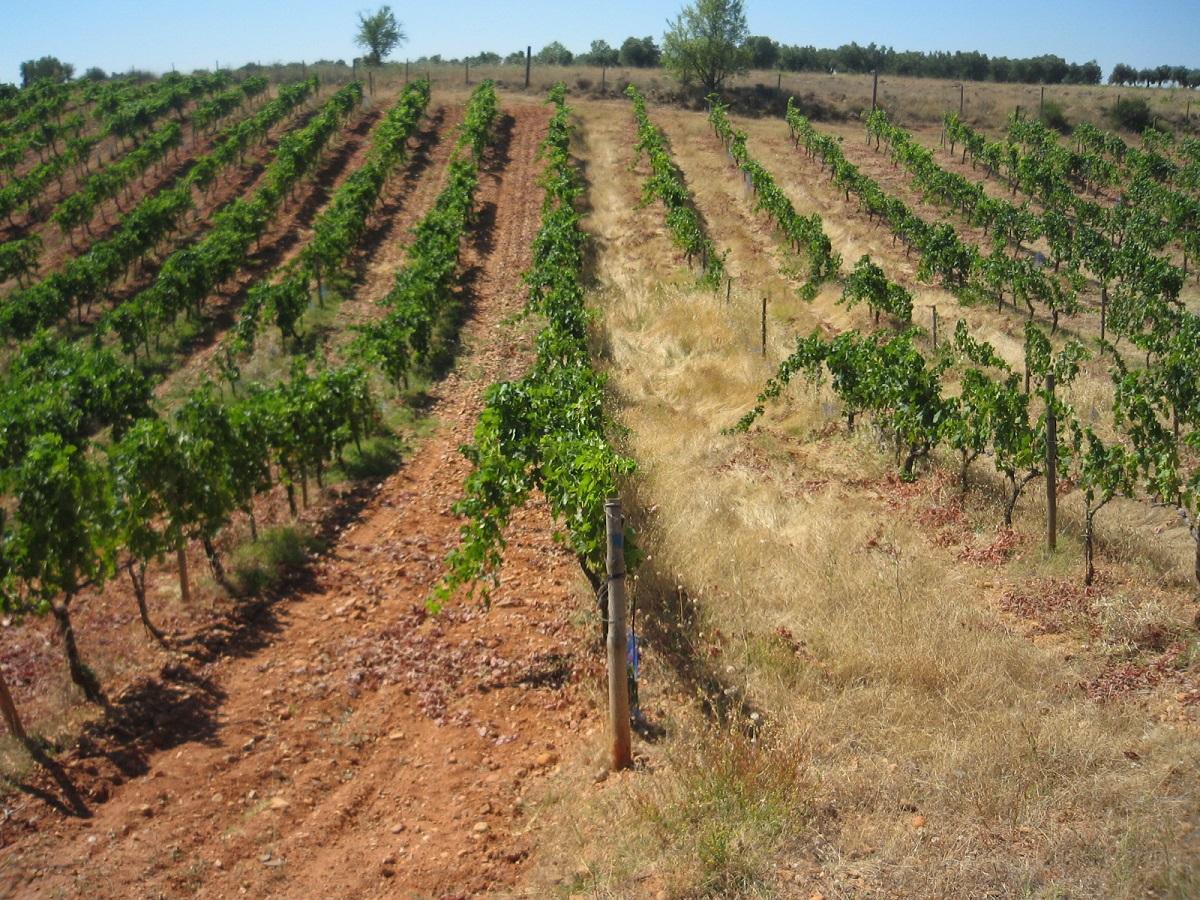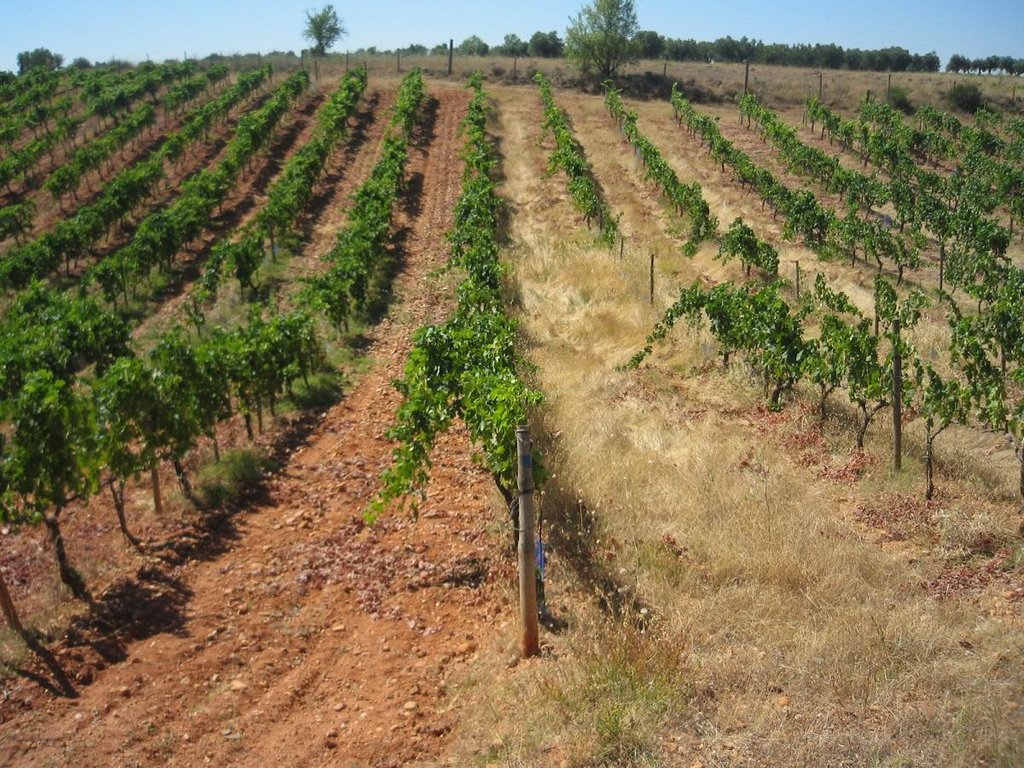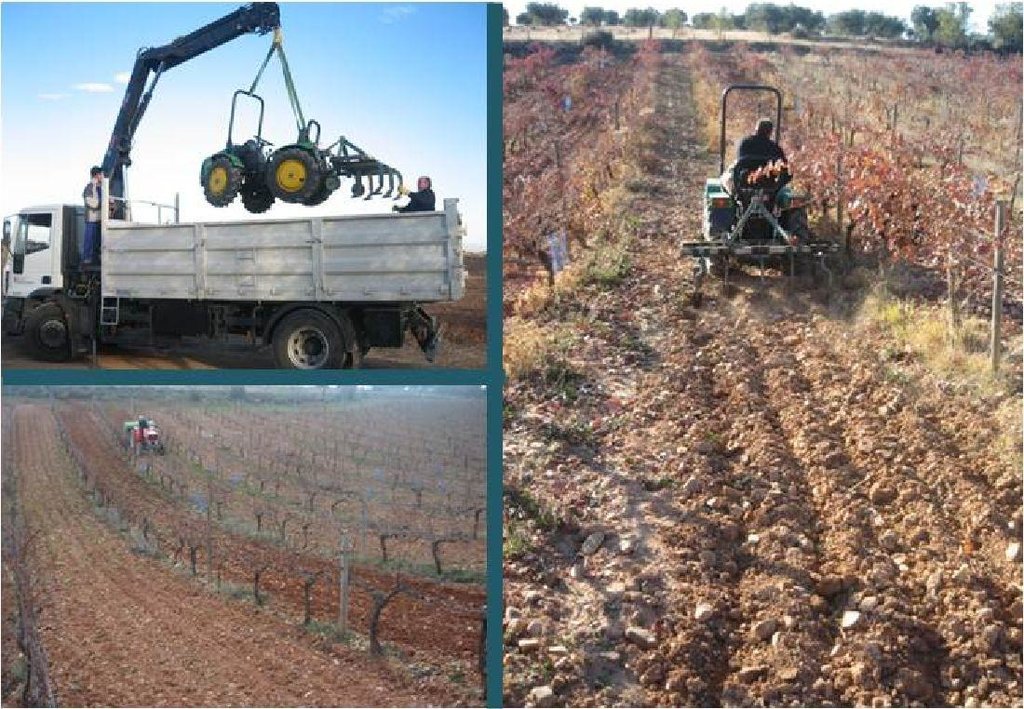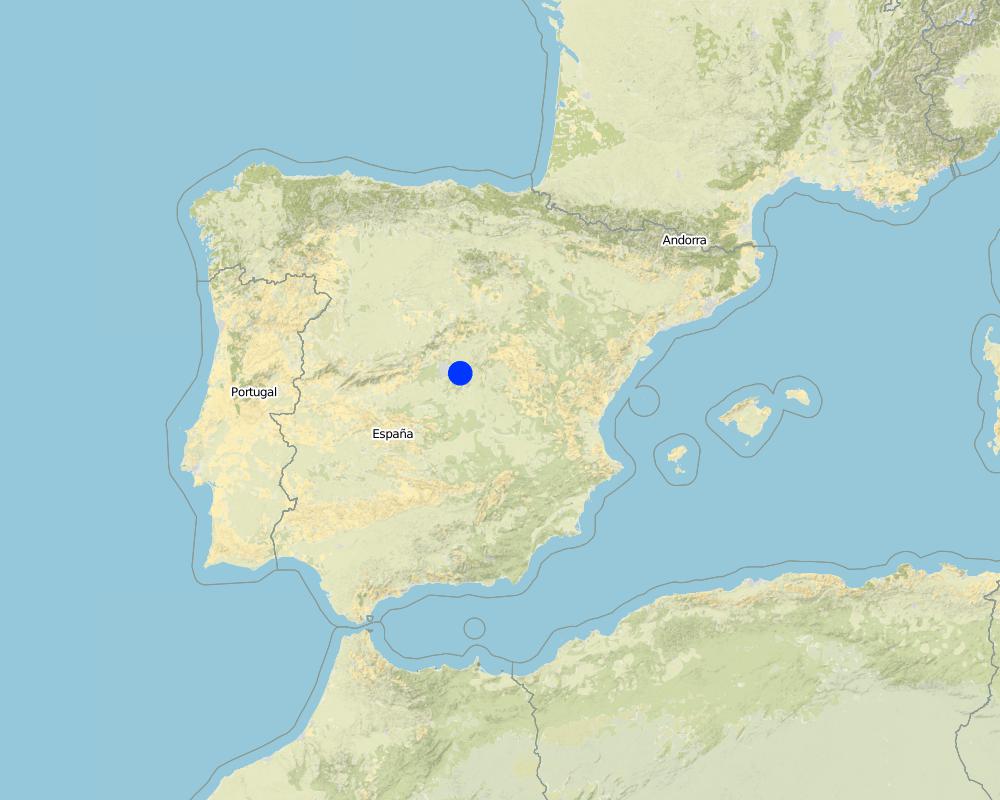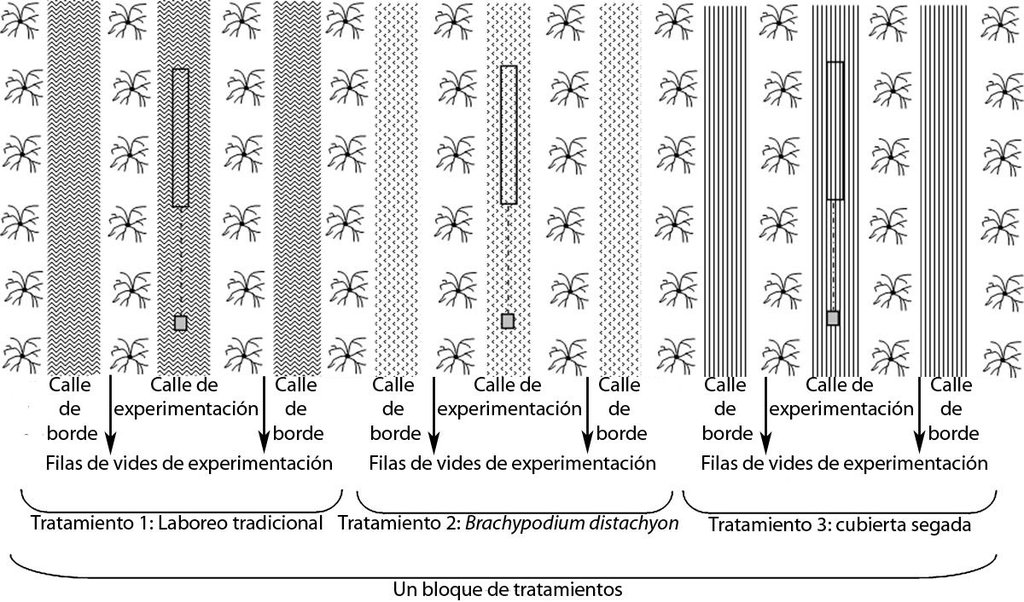Cover crops in organic vineyard [إسبانيا]
- تاريخ الإنشاء:
- تحديث:
- جامع المعلومات: CELIA BARBERO SIERRA
- المحرر: –
- المراجعون: Fabian Ottiger, Alexandra Gavilano
Cubiertas vegetales en calles de viñedos
technologies_1162 - إسبانيا
عرض الأقسام
توسيع الكل طي الكل1. معلومات عامة
1.2 تفاصيل الاتصال بالأشخاص الرئيسيين لمصدر المعلومات والمؤسسات المشاركة في تقييم وتوثيق التقنية
متخصص في الإدارة المستدامة للأراضي:
متخصص في الإدارة المستدامة للأراضي:
Ruíz Colmenero Marta
Instituto Madrileño de Investigación y Desarrollo Rural, Agrario y Alimentario - IMIDRA
إسبانيا
متخصص في الإدارة المستدامة للأراضي:
Bienes Ramon
Instituto Madrileño de Investigación y Desarrollo Rural, Agrario y Alimentario - IMIDRA
اسم المؤسسة (المؤسسات) التي سهلت توثيق/تقييم التقنية (إذا كان ذلك على صلة)
UNIVERSIDAD AUTONOMA DE MADRID (UNIVERSIDAD AUTONOMA DE MADRID) - إسبانيااسم المؤسسة (المؤسسات) التي سهلت توثيق/تقييم التقنية (إذا كان ذلك على صلة)
IMIDRA (IMIDRA) - إسبانيا1.3 الشروط المتعلقة باستخدام البيانات الموثقة من خلال WOCAT
يوافق جامع المعلومات والشخص (لاشخاص) الرئيسي لمصدر المعلومات على الشروط المتعلقة باستخدام البيانات الموثقة من خلال WOCAT:
نعم
2. وصف تقنيةالإدارة المستدامي للأراضي
2.1 وصف مختصر للتقنية
تعريف التقنية:
Use of cover crops to prevent erosion and increase soil organic matter.
2.2 وصف تفصيلي للتقنية
الوصف:
In total there were 66 rows of vineyards of the Tempranillo red variety, spaced 3 m apart with a distance of 2.5 m between vines. To date they have been worked using conventional tilling without herbicides: most of the work is done mainly in the winter, followed by two or three sessions in spring aimed at controlling the growth of weeds, which is conditioned by the spring rains.
The technology is based on minimum tillage and the use of Secale cereale L and Brachypodium distachyon (L.) as cover crops to protect the soil against erosion and to increase the organic matter.
Purpose of the Technology: The main purposes of this technology are to fight against erosion and water runoff and to increase soil organic matter.
Indirectly this technology contributes to increase biodiversity in the vineyards and it could have some positive effects on wine quality (related to the content of sugar and poliphenoles) as proved by some authors (Dry et al., 2001).
Cover crops usually increase the soil moisture but on the other hand, along the summer, the cover crops and the vines are in competition for the scarce water available in the area.
Establishment / maintenance activities and inputs: The plant cover in the centre of the rows was sown in mid-November, following the copious rains in the autumn of 2006. A minimum tillage (15cm depth) is carried out before sowing. The seeding rates were 70 kg/ha for rye, Secale cereale L., and 40 kg/ha for purple false brome, Brachypodium distachyon (L.) P. Beauv. This latter cover had to be reseeded by hand since the seeds have to be buried at a very low depth. It sprouts in late winter or early spring and by late June it is already mature and dry, at which point it self-sows and it sprouts spontaneously again the following autumn. The Secale cover has to be cut in spring and re-sown in late autumn.
Once sown, the resulting vineyard was divided into alternating rows with three treatments: bare soil with traditional tilling, rows covered with Secale and rows covered with Brachypodium.
The maintenance activities consist of no tillage in winter and conservation of natural cover crops until spring.
Natural / human environment: The area is at an altitude of 800 m, in a semiarid Mediterranean climate where the recorded annual rainfall is below 400 mm and the average annual temperature is 14 ºC, with very hot and occasionally stormy summers and very cold winters. It rains primarily in spring and autumn.
The farmland is predominantly dry, especially where olives and vines are planted. Oaks (holm, Portuguese and hermes) can be found in nearby wild areas and in abandoned terrains. The study focused on the area of Campo Real in the southeast of Madrid, in the centre of Spain. The vineyard covers an area of some 2 ha of rolling hills and is located on top of limestone marl.
The farmer is the owner of the land where the technology was implemented as well as he owns other plots. The land user is one of the few organic producers in the region.
2.3 صور التقنية
2.5 البلد/المنطقة/المواقع التي تم تنفيذ التقنية فيها والتي يغطيها هذا التقييم
البلد:
إسبانيا
المنطقة/الولاية/المحافظة:
Madrid, Spain
مزيد من التفاصيل حول الموقع:
Campo Real
التعليقات:
Total area covered by the SLM Technology is 0.02 km2.
Map
×2.6 تاريخ التنفيذ
في حالة عدم معرفة السنة بالتحديد، يرجى الإشارة إلى التاريخ التقريبي:
- منذ أقل من 10 سنوات (مؤخرًا)
2.7 إدخال التقنية
حدد كيف تم إدخال التقنية:
- أثناء التجارب/الأبحاث
- من خلال المشاريع/ التدخلات الخارجية
التعليقات (نوع المشروع، الخ):
Projects FP 06-DR3-VID IMIDRA and RTA2007-86 INIA, Bodegas y Viñedos Gosálbez-Ortí.
3. تصنيف تقنية الإدارة المستدامي للأراضي
3.2 نوع (أنواع) استخدام الأراضي الحالية حيث يتم تطبيق التقنية
استخدامات الأراضي مختلطة ضمن نفس وحدة الأرض:
نعم
حدد استخدام الأراضي المختلطة (المحاصيل / الرعي / الأشجار):
- الرعي الزراعي (بما في ذلك الإدارة المتكاملة للمحاصيل والثروة الحيوانية)

الأراضي الزراعية
- زراعة الأشجار والشجيرات
- grass see
عدد مواسم الزراعة في السنة:
- 1
حدد:
Longest growing period in days: 75Longest growing period from month to month: February-April (Secale cereale)Second longest growing period in days: 90Second longest growing period from month to month: February-June (B distachyon)

غير ذلك
حدد:
Grass species: rye (Secale cereale) and bromus (Brachypodium distachyon) (2m)
التعليقات:
Major land use problems (compiler’s opinion): Erosion and low soil organic matter content.
Major land use problems (land users’ perception): Water scarcity, climatic extreme events, low agricultural income.
3.4 إمدادات المياه
إمدادات المياه للأرض التي يتم تنفيذ التقنية عليها:
- بعلية
3.5 مجموعةالإدارة المستدامة للأراضي التي تنتمي إليها هذه التقنية
- تحسين الغطاء الأرضي/النباتي
3.6 التدابير التقنية في مجال إلادارة المستدامة للأراضي

التدابير الزراعية
- A1: الغطاء النباتي/التربة
- A2: المادة العضوية/خصوبة التربة
- A3: معالجة سطح التربة
التعليقات:
Main measures: agronomic measures
Type of agronomic measures: better crop cover, contour planting / strip cropping, cover cropping, mulching, manure / compost / residues, breaking crust / sealed surface, minimum tillage
3.7 الأنواع الرئيسية من تدهور الأراضي التي تناولتها التقنية

تآكل التربة بالمياه
- الوزن(Wt): فقدان التربة السطحية/تآكل السطح

التدهور الكيميائي للتربة
- (Cn): تراجع الخصوبة وانخفاض محتوى المادة العضوية (غير ناتج عن الانجراف)

التدهور المادي أو الفيزيائي للتربة
- (Pc) : تراص التربة
- (Pk)ظهور وتكون قشرة سطحية

التدهور البيولوجي
- (Bl): فقدان الحياة بالتربة
التعليقات:
Main type of degradation addressed: Wt: loss of topsoil / surface erosion
Secondary types of degradation addressed: Cn: fertility decline and reduced organic matter content, Pc: compaction, Pk: sealing and crusting, Bl: loss of soil life
Main causes of degradation: soil management (Bare soil by traditional tillage in sloping lands), deforestation / removal of natural vegetation (incl. forest fires) (Lack of vegetation increases soil erodibility), disturbance of water cycle (infiltration / runoff) (Increase the annual rate of rain infiltration due to high vegetation cover), Heavy / extreme rainfall (intensity/amounts) (Extreme events- storms), droughts
Secondary causes of degradation: other natural causes (avalanches, volcanic eruptions, mud flows, highly susceptible natural resources, extreme topography, etc.) specify (Slope between 10 to 15%), land tenure (Uncertainties on future land tenure implies overexploitation of land in the short run)
3.8 منع أو حد أو عكس تدهور الأراضي
تحديد هدف التقنية فيما يتعلق بتدهور الأراضي:
- منع تدهور الأراضي
- الحد من تدهور الأراضي
التعليقات:
Main goals: prevention of land degradation
Secondary goals: mitigation / reduction of land degradation
4. المواصفات الفنية، وأنشطة التنفيذ، والمدخلات، والتكاليف
4.1 الرسم الفني للتقنية
المواصفات الفنية (المتعلقة بالرسم الفني):
Cover crops are sown in the middle of the strips of the lines of vineyard.(Bare soil under the vines: 50 cm wide; cropped strips: 2 m wide)
Location: Campo Real. Madrid, Spain
Date: 2008
Technical knowledge required for field staff / advisors: moderate (Selection of cover crops and management.
Botanical and agronomic knowledge required.)
Technical knowledge required for land users: moderate (Use of appropriate machinery.)
Main technical functions: control of raindrop splash, control of dispersed runoff: retain / trap, control of dispersed runoff: impede / retard, improvement of ground cover, increase of surface roughness, improvement of surface structure (crusting, sealing), improvement of topsoil structure (compaction), stabilisation of soil (eg by tree roots against land slides), increase in organic matter, increase of infiltration, sediment retention / trapping, sediment harvesting, increase of biomass (quantity), promotion of vegetation species and varieties (quality, eg palatable fodder)
Secondary technical functions: increase in nutrient availability (supply, recycling,…), increase / maintain water stored in soil, increase of groundwater level / recharge of groundwater
Better crop cover
Material/ species: Secale cereale
Quantity/ density: 70 kg/ha
Remarks: decrease soil erosion and it does not compete for water.
Contour planting / strip cropping
Material/ species: Vineyard plus cereals
Remarks: bare soil under the vines: 50 cm wide; cropped strips: 2 m wide
Cover cropping
Material/ species: Brachypodium distachyon
Quantity/ density: 40 kg/ha
Remarks: best coverage and SOM increase, but reduces the grape production too much due to water competition
Mulching
Material/ species: Straw of Secale cereale
Remarks: Conservation of cut rye on site
Manure / compost / residues
Material/ species: Secale cereale and Brachypodium distachyon
Remarks: roots and residues (straw) left in soil increase SOM
Breaking crust / sealed surface
Remarks: cover crops avoid soil crusting
Minimum tillage
Material/ species: up to 15 cm soil depth
Quantity/ density: 15 cm
Remarks: before sowing
Vegetative measure: in the middle of the lines of vines
Vegetative material: G : grass
Vegetative measure: Vegetative material: G : grass
Vegetative measure: Vegetative material: G : grass
Vegetative measure: Vegetative material: G : grass
Fruit trees / shrubs species: Grapes (50cm) /grass see G (cover crops) (2m)
Grass species: rye (Secale cereale) and bromus (Brachypodium distachyon) (2m)
المؤلف:
María José Marqués, Universidad Autónoma de Madrid
4.2 معلومات عامة بخصوص حساب المدخلات والتكاليف
عملة أخرى/ عملة وطنية (حدد):
euro
إذا كان ذا صلة، وضح سعر الصرف من الدولار الأمريكي إلى العملة المحلية (على سبيل المثال، 1 دولار أمريكي = 79.9 ريال برازيلي): 1 دولار أمريكي =:
1,34
اذكر متوسط تكلفة أجر العمالة المستأجرة في اليوم الواحد:
46.90
4.3 أنشطة التأسيس
| النشاط | التوقيت (الموسم) | |
|---|---|---|
| 1. | Buy secale cereale seed, 70 kg per ha | |
| 2. | Buy B. distachyon seed, 40 kg per ha |
4.4 التكاليف والمدخلات اللازمة للتأسيس
| تحديد المدخلات | الوحدة | الكمية | التكاليف لكل وحدة | إجمالي التكاليف لكل مدخل | % من التكاليف التي يتحملها مستخدمو الأراضي | |
|---|---|---|---|---|---|---|
| العمالة | Labour | ha | 1,0 | 140,7 | 140,7 | 100,0 |
| معدات | Machine use | ha | 1,0 | 51,46 | 51,46 | 100,0 |
| المواد النباتية | Seeds | ha | 1,0 | 354,43 | 354,43 | |
| إجمالي تكاليف إنشاء التقنية | 546,59 | |||||
| إجمالي تكاليف إنشاء التقنية بالدولار الأمريكي | 407,9 | |||||
التعليقات:
Duration of establishment phase: 6 month(s)
Life span of the product: B. distachyon seed, 4-5 years
Life span of the product: Secale cereale seed, 1 year
4.5 الصيانة/الأنشطة المتكررة
| النشاط | التوقيت/الوتيرة | |
|---|---|---|
| 1. | Minimum tillage and seeding in one go (Secale cereale) | Annually in late autumn or winter |
| 2. | Seeding (B distachyon) | Every 5 years |
| 3. | Mowing Secale cereale 1 ha | Once a year |
4.6 التكاليف والمدخلات اللازمة للصيانة/للأنشطة المتكررة (سنويًا)
| تحديد المدخلات | الوحدة | الكمية | التكاليف لكل وحدة | إجمالي التكاليف لكل مدخل | % من التكاليف التي يتحملها مستخدمو الأراضي | |
|---|---|---|---|---|---|---|
| العمالة | Labour | ha | 1,0 | 140,7 | 140,7 | 100,0 |
| معدات | Machine use | ha | 1,0 | 51,46 | 51,46 | 100,0 |
| المواد النباتية | Seeds | ha | 1,0 | 113,23 | 113,23 | |
| إجمالي تكاليف صيانة التقنية | 305,39 | |||||
| إجمالي تكاليف صيانة التقنية بالدولار الأمريكي | 227,9 | |||||
التعليقات:
Machinery/ tools: tractor, brushcutter
Grass strips per hectare in 2008.
4.7 أهم العوامل المؤثرة على التكاليف
قدم وصفا لأهم العوامل التي تؤثر على التكاليف:
Labour and price of B. distachyon seeds as it is not a commercial seed.
5. البيئة الطبيعية والبشرية
5.1 المناخ
هطول الأمطار السنوي
- < 250 مم
- 251- 500 ملم
- 501 - 750ملم
- 1,000-751 ملم
- 1,500-1,100 ملم
- 2,000-1,500 ملم
- 3,000-2,001 ملم
- 4,000-3,100 ملم
- > 4000 ملم
حدد متوسط هطول الأمطار السنوي (إذا كان معروفًا)، بالملليمتر:
400,00
المواصفات/التعليقات على هطول الأمطار:
Autumn and spring
المنطقة المناخية الزراعية
- شبه قاحلة
Thermal climate class: temperate
5.2 طوبوغرافيا
متوسط الانحدارات:
- مسطح (0-2%)
- بسيط (3-5%)
- معتدل (6-10%)
- متدحرج (11-15%)
- تلال (16-30%)
- شديدة الانحدار(31-60%)
- فائقة الانحدار (>60%)
التضاريس:
- هضاب/سهول
- أثلام مرتفعة
- المنحدرات الجبلية
- منحدرات التلال
- منحدرات في السفوح
- قاع الوادي
المنطقة الارتفاعية:
- 100-0 متر فوق سطح البحر
- 500-101 متر فوق سطح البحر
- 1,000-501 متر فوق سطح البحر
- 1,500-1,001 متر فوق سطح البحر
- 2,000-1,501 متر فوق سطح البحر
- 2,500-2,100 متر فوق سطح البحر
- 3,000-2,501 متر فوق سطح البحر
- 4,000-3,001 متر فوق سطح البحر
- > 4000 متر فوق سطح البحر
وضح ما إذا كانت التقنية مطبقة على وجه التحديد في:
- حالات مقعرة
التعليقات والمواصفات الإضافية بشأن التضاريس:
Slopes on average: Rolling (10-14%)
5.3 التربة
متوسط عمق التربة:
- ضحل جدًا (0-20 سم)
- ضحلة (21-50 سم)
- متوسطة العمق (51-80 سم)
- عميقة (81-120 سم)
- عميقة جدًا (> 120 سم)
قوام التربة (التربة السطحية):
- متوسط ( طميي، سلتي)
المواد العضوية في التربة السطحية:
- متوسطة (1-3%)
إذا كان متاحًا، قم بإرفاق وصف كامل للتربة أو تحديد المعلومات المتوفرة، على سبيل المثال نوع التربة، الرقم الهيدروجيني/ درجة حموضة التربة، قدرة التبادل الكاتيوني، النيتروجين، الملوحة وما إلى ذلك.
Soil texture is medium (sandy loam)
Soil fertility is medium
Topsoil organic matter is medium (1.3%)
Soil drainage/infiltration is medium
Soil water storage capacity is medium
5.4 توافر المياه ونوعيتها
توافر المياه السطحية:
متوسط
نوعية المياه (غير المعالجة):
مياه الشرب سيئة (تتطلب معالجة)
تعليقات ومواصفات أخرى بشأن نوعية المياه وكميتها:
Ground water table: No data avalilable
Availability of surface of water: During the maximum water requirements of vines (June-July) water is not available usually.
5.5 التنوع البيولوجي
تنوع الأنواع:
- منخفض
5.6 خصائص مستخدمي الأراضي الذين يطبقون التقنية
التوجه السوقي لنظام الإنتاج:
- تجاري/سوق
المستوى النسبي للثروة:
- متوسط
أفراداً أو مجموعات:
- فرد/أسرة معيشية
مستوى المكننة:
- ميكانيكية/ مزودة بمحرك
الجنس:
- رجال
اذكر الخصائص الأخرى ذات الصلة لمستخدمي الأراضي:
Land users applying the Technology are mainly Leaders / privileged
Difference in the involvement of women and men: Traditionally vineyard sector in Spain is driven by men.
Population density: 10-50 persons/km2
Annual population growth: negative
Off-farm income specification: This information is not available.
Market orientation is commercial/market (wine).
5.7 متوسط مساحة الأرض التي يستخدمها مستخدمو الأراضي الذين يطبقون التقنية
- < 0.5 هكتارا
- 0.5 - 1 هكتار
- 1 -2 هكتار
- 2 - 5 هكتار
- 5 - 15 هكتار
- 15 - 50 هكتار
- 50 - 100هكتار
- 500-100 هكتار
- 1,000-500 هكتار
- 10,000-1,000 هكتار
- > 10,000 هكتار
هل يعتبر هذا نطاقًا صغيرًا أو متوسطًا أو واسعا (في إشارة إلى السياق المحلي)؟:
- على نطاق صغير
5.8 ملكية الأراضي، وحقوق استخدام الأراضي، وحقوق استخدام المياه
ملكية الارض:
- فردية، يوجد سند ملكية
حقوق استخدام الأراضي:
- فردي
حقوق استخدام المياه:
- فردي
5.9 الوصول إلى الخدمات والبنية التحتية
الصحة:
- ضعيف
- معتدل
- جيد
التعليم:
- ضعيف
- معتدل
- جيد
المساعدة التقنية:
- ضعيف
- معتدل
- جيد
العمل (على سبيل المثال خارج المزرعة):
- ضعيف
- معتدل
- جيد
الأسواق:
- ضعيف
- معتدل
- جيد
الطاقة:
- ضعيف
- معتدل
- جيد
الطرق والنقل:
- ضعيف
- معتدل
- جيد
مياه الشرب وخدمات الصرف الصحي:
- ضعيف
- معتدل
- جيد
الخدمات المالية:
- ضعيف
- معتدل
- جيد
6. الآثار والتصريحات الختامية
6.1 الآثار التي أظهرتها التقنية في الموقع
الآثار الاجتماعية والاقتصادية
الإنتاج
إنتاج المحاصيل
التعليقات/ حدد:
Depending on the cover crop (B. distachyon)
إنتاج الأعلاف
التعليقات/ حدد:
But not really used
توافر المياه ونوعيتها
توافر مياه الري
نوعية مياه الري
الطلب على مياه الري
الدخل والتكاليف
دخل المزرعة
التعليقات/ حدد:
Related to the quality and price of wine
عبء العمل
التعليقات/ حدد:
No tillage
الآثار الاجتماعية والثقافية
المعرفة بالإدارة المستدامة للأراضي/تدهور الأراضي
Landusers perception of the landscape
التعليقات/ حدد:
The farmers use to prefer the landscape of their vineyards with "clean" soil. They consider cover crops as weeds.
Improved livelihoods and human well-being
التعليقات/ حدد:
This SLM Technology contributes to soil improvement but has no direct impacts on human wellbeing of the land users. Due to organic labelling of the product, the price of wine may increase wich also increases farm income.
الآثار الايكولوجية
دورة المياه / الجريان السطحي
الجريان السطحي
التعليقات/ حدد:
More than 80% of runoff reduction in B. distachyon and more than 60% for Secale.
التبخر
التربة
رطوبة التربة
التعليقات/ حدد:
Depending on the cover. B. distachyon increases soil moisture in autumn and winter. From May to July soil moisture heavely decreased, the rest of the year the cover crops increase soil moisture compared with bare soil
غطاء التربة
فقدان التربة
التعليقات/ حدد:
93% in permanent cover crops
تكون قشرة التربة السطحية/انسداد مسام التربة
تراص التربة
التعليقات/ حدد:
Due to less use of heavy machinery
المادة العضوية في التربة/تحت الطبقة c
الكمية قبل الإدارة المستدامة للأراضي:
1.27%
الكمية بعد الإدارة المستدامة للأراضي:
1.6%
التعليقات/ حدد:
From 1.27% to 1.6% in three years for permanent covers
6.2 الآثار التي أظهرتها التقنية خارج الموقع
توافر المياه
الفيضان في اتجاه مجرى النهر
تلوث المياه الجوفية/الأنهار
القدرة على التخفيف / الترشيح
الرواسب المنقولة بواسطة الرياح
الأضرار التي لحقت بحقول الجيران
الضرر على البنية التحتية العامة/ الخاصة
6.3 تعرض التقنية وحساسيتها لتغير المناخ التدريجي والظواهر المتطرفة/الكوارث المرتبطة بالمناخ (كما يراها مستخدمو الأراضي)
تغير مناخ تدريجي
تغير مناخ تدريجي
| الموسم | زيادة أو نقصان | كيف تتعامل التقنية مع ذلك؟ | |
|---|---|---|---|
| درجة الحرارة السنوية | زيادة | جيدا |
الظواهر المتطرفة / الكوارث المرتبطة بالمناخ
الكوارث الجوية
| كيف تتعامل التقنية مع ذلك؟ | |
|---|---|
| عاصفة ممطرة محلية | جيدا |
| عاصفة هوائية محلية | غير معروف |
الكوارث المناخية
| كيف تتعامل التقنية مع ذلك؟ | |
|---|---|
| جفاف | جيدا |
الكوارث الهيدرولوجية
| كيف تتعامل التقنية مع ذلك؟ | |
|---|---|
| فيضان عام (نهر) | ليس جيدا |
العواقب الأخرى المتعلقة بالمناخ
العواقب الأخرى المتعلقة بالمناخ
| كيف تتعامل التقنية مع ذلك؟ | |
|---|---|
| انخفاض فترة النمو | جيدا |
التعليقات:
The species were chosen to be tolerant to drought and poor soil conditions
6.4 تحليل التكلفة والعائد
كيف يمكن مقارنة العوائد نسبة لتكاليف الإنشاء (من وجهة نظر مستخدمي الأراضي)؟
عوائد قصيرة الأجل:
محايد/متوازن
عوائد طويلة الأجل:
إيجابي قليلا
كيف تتم مقارنة العوائدمع كلفة الصيانة/التكاليف المتكررة (من وجهة نظر مستخدمي الأراضي)؟
عوائد قصيرة الأجل:
محايد/متوازن
عوائد طويلة الأجل:
إيجابي قليلا
التعليقات:
This particular land user is an organic farmer and he is willing to change his manangament practices but tradtional farmers in the region have a very negative vision of this kind of SLM techs.
6.5 اعتماد التقنية
إذا كان متاحًا، قم بتحديد الكمية (عدد الأسر المعيشية و/أو المساحةالمغطاة):
1
التعليقات:
100% of land user families have adopted the Technology with external material support
1 land user families have adopted the Technology with external material support
There is no trend towards spontaneous adoption of the Technology
6.7 نقاط القوة / المزايا / الفرص التي توفرها التقنية
| نقاط القوة/ المزايا/ الفرص من وجهة نظر مستخدمي الأراضي |
|---|
|
Increase in wine quality How can they be sustained / enhanced? Maintaining this SLM practice along the time |
|
Prevention of erosion How can they be sustained / enhanced? Maintaining this SLM practice along the time |
|
Decrease in intensity and frequency of tillage How can they be sustained / enhanced? Maintaining this SLM practice along the time |
| نقاط القوة/ المزايا/ الفرص من وجهة نظر جامع المعلومات أو غيره من الاشخاص الرئيسيين لمصدر المعلومات |
|---|
|
Increase of soil organic matter How can they be sustained / enhanced? Maintaining this SLM practice along the time |
|
Prevention of runoff and soil erosion (change of bare (tilled) soil by cover crops) How can they be sustained / enhanced? Maintaining this SLM practice along the time |
|
Increase in biodiversity How can they be sustained / enhanced? Maintaining this SLM practice along the time |
|
Increase in wine quality (related to the content of sugar and polyphenols), as proved by some authors (Dry et al., 2001) How can they be sustained / enhanced? Maintaining this SLM practice along the time |
|
The costs are reduced through reduced use of tractor (decreased intensity of tillage) How can they be sustained / enhanced? Maintaining this SLM practice along the time |
6.8 نقاط ضعف / مساوىء / مخاطر التقنية وسبل التغلب عليها
| نقاط الضعف/ المساوىء/ المخاطر من وجهة نظر مستخدم الأراضي | كيف يمكن التغلب عليها؟ |
|---|---|
| Lack of knowledge or training to adopt this technologies | Awareness raising campaigns |
| نقاط الضعف/ المساوىء/ المخاطر من وجهة نظر جامع المعلومات أو غيره من الاشخاص الرئيسيين لمصدر المعلومات | كيف يمكن التغلب عليها؟ |
|---|---|
| Soil moisture decreases during certain months | Mowing the cover in spring |
| High costs of the most effective seed (8.04$/kg) (B. distachyon) | Using other similar and cheaper seeds |
7. المراجع والروابط
7.1 طرق جمع/مصادر المعلومات
7.2 المراجع للمنشورات المتاحة
العنوان، المؤلف، السنة، النظام القياسي الدولي لترقيم الكتب ISBN:
M.J. Marques , S. García-Muñoz , G. Muñoz-Organero , R. Bienes. 2009. Soil conservation beneath grass cover in hillside vineyards under mediterranean climatic conditions. Land Degradation and Development. 21: 122-131.
Ruiz-Colmenero, S; Bienes R.; Marques MJ. 2011. Soil and water conservation dilemmas associated with the use of green cover in steep vineyards. Soil & Tillage Research 117, 211-223.
Bienes R., Marques MJ, Ruiz Colmenero M 2012. Cereales, viñedos y olivares. El manejo tradicional del suelo y sus consecuencias en la erosión hídrica. La erosión y la hidrología en campos de cultivo en España. Cuadernos de Investigación Geográfica 38(1), 49-74.
Ruiz-Colmenero, M., Bienes, R., Eldridge, D.J. and Marqués, M.J. 2013. Vegetation cover reduces erosion and enhances soil organic carbon in a vineyard in the central Spain. Catena. 104, 153-160.
الروابط والوحدات المواضيعية
توسيع الكل طي الكلالروابط
لا يوجد روابط
الوحدات المواضيعية
لا يوجد وحدات مواضيعية


